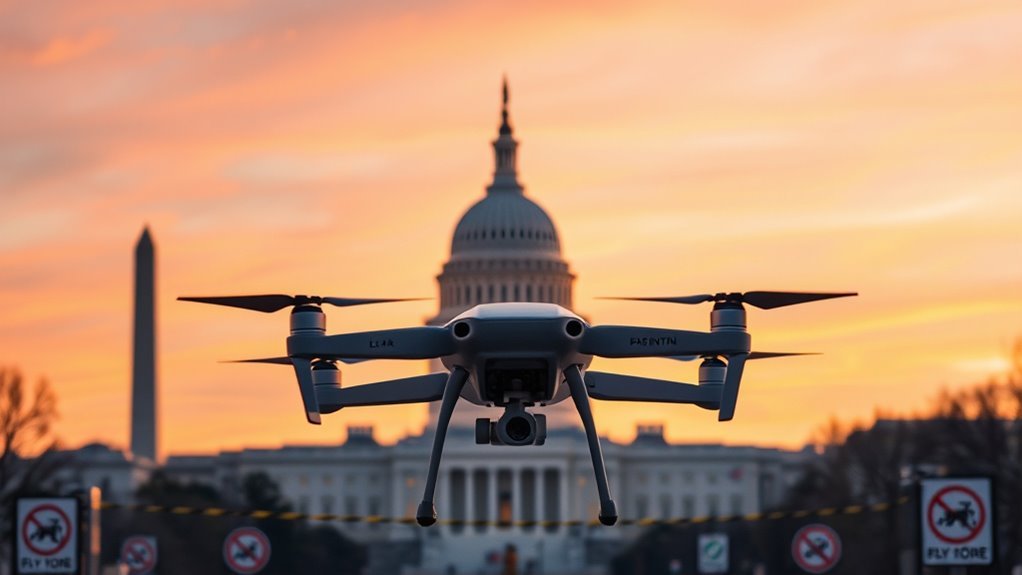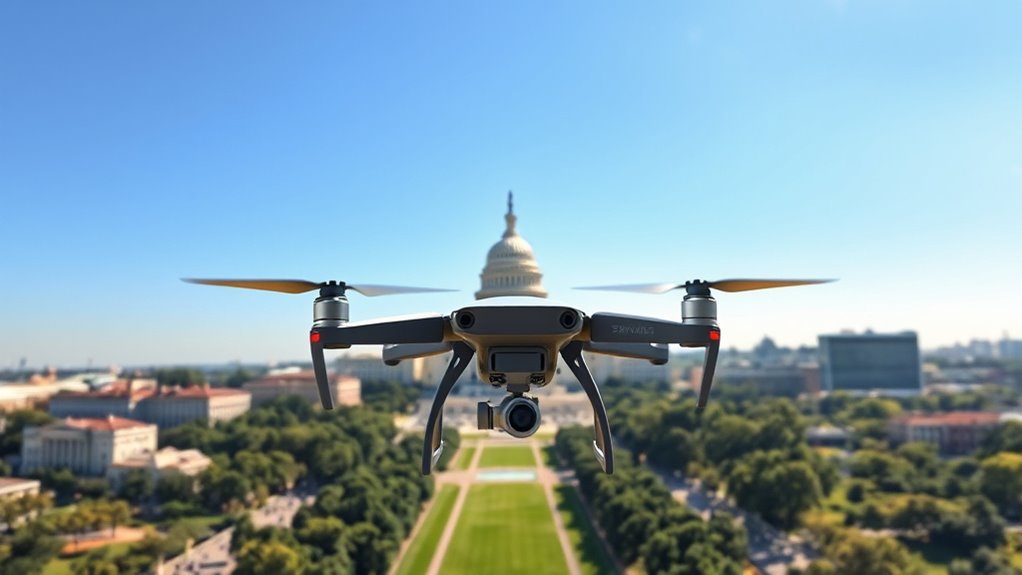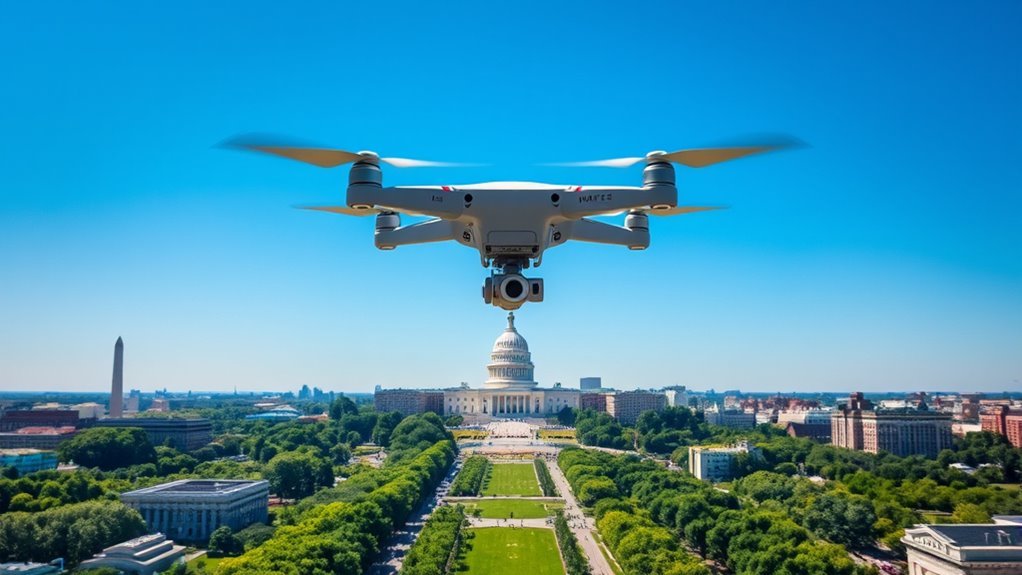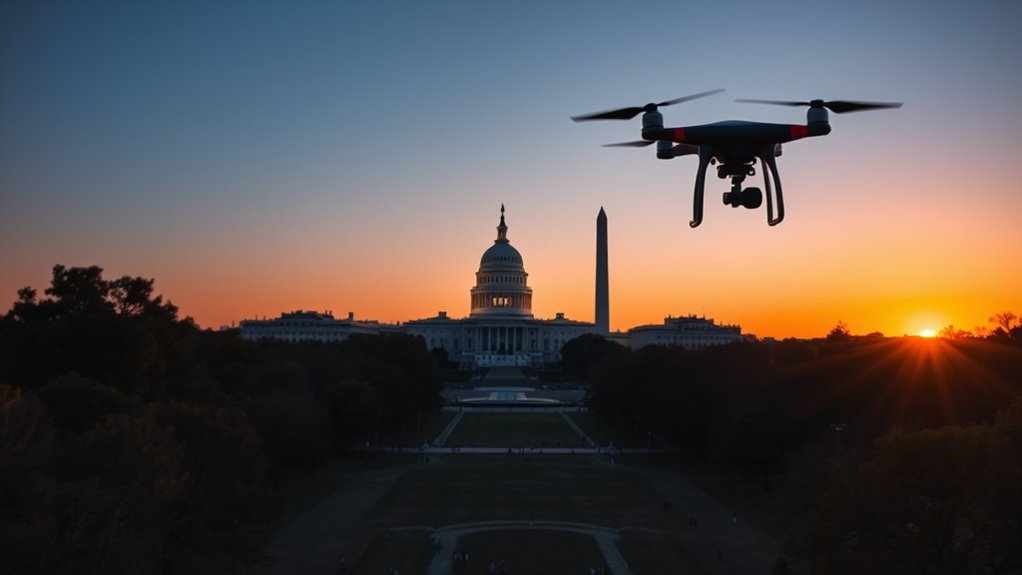When flying a drone in Washington D.C., you must know the no-fly zones, register your drone if it weighs over 0.55 pounds, and follow FAA regulations. Always respect privacy rights by avoiding private property and crowded areas. Keep your altitude below 400 feet and maintain visual line-of-sight. Monitor weather conditions and have a plan for emergencies. Regular inspections and adequate maintenance are key for safety. Stay informed about specific rules to guarantee a hassle-free flying experience.
Understand the No-Fly Zones

When operating a drone in Washington D.C., it’s crucial to understand the no-fly zones, as flying in restricted areas can lead to serious legal consequences. You’ll want to familiarize yourself with the no-fly maps provided by the FAA, which outline the restricted airspace in the capital. Key areas include the vicinity of the White House, the Capitol Building, and various federal facilities. Ignoring these restrictions not only jeopardizes public safety but can also result in hefty fines or legal action. Always check for updates, as restricted airspace can change. Utilizing apps that provide real-time information on no-fly zones can enhance your flying experience while ensuring you respect the boundaries set for drone operation. Stay informed, fly responsibly.
Register Your Drone

Before you take to the skies with your drone in Washington D.C., it’s essential to register your device with the Federal Aviation Administration (FAA). This drone registration is a straightforward process that you can complete online. Ensuring your drone is registered not only complies with regulations but also promotes safety in the skies.
Here’s what you need to know:
- You must register if your drone weighs more than 0.55 pounds.
- The registration fee is $5, valid for three years.
- You’ll receive a unique registration number to display on your drone.
- Keep your information updated if you change addresses or sell your drone.
Don’t skip this step; it’s crucial for enjoying your freedom to fly responsibly!
Follow FAA Regulations

Understanding and adhering to FAA regulations is essential for safe and legal drone operation in Washington D.C. You must be aware of the specific airspace classifications that govern where you can fly. Most importantly, the National Airspace System includes restricted areas that require careful navigation to guarantee drone safety. Always check the FAA’s B4UFLY app for real-time airspace updates and restrictions. Staying below 400 feet and maintaining visual line-of-sight with your drone are also critical. Remember, flying near airports or restricted government buildings can lead to severe penalties. By consistently following these regulations, you not only promote drone safety but also enhance your freedom to operate in the skies responsibly. Stay informed, stay compliant, and enjoy your flying experience.
Obtain Necessary Permits
To fly a drone legally in Washington D.C., you often need to obtain specific permits, especially for commercial use or when operating in restricted areas. Understanding the permit application process is essential for responsible drone usage. Here’s what you need to take into account:
- Identify required permits for your specific drone usage.
- Submit a detailed permit application that meets all regulatory requirements.
- Allow time for processing; some permits can take weeks to approve.
- Stay updated on local regulations as they can change frequently.
Respect Privacy Rights
When flying a drone in Washington D.C., it’s essential to understand local privacy laws to avoid legal issues. You’ll need to steer clear of private property areas unless you obtain explicit permissions from property owners. Respecting these privacy rights not only helps you stay compliant but also fosters trust within the community.
Understand Local Privacy Laws
In Washington D.C., it’s important to recognize that privacy rights are protected under various local laws, which can greatly impact your drone operations. Maneuvering these laws is vital to avoid any legal issues, especially concerning data protection and surveillance concerns. Here are key points to keep in mind:
- Always respect individuals’ right to privacy.
- Avoid capturing images or videos of private property without permission.
- Be aware of local regulations regarding data collection and storage.
- Understand the consequences of infringing on privacy rights, which can include fines or legal action.
Avoid Private Property Areas
Respecting privacy rights extends beyond understanding local laws; it also involves avoiding private property areas while flying your drone. Straying into private property boundaries can lead to violations of drone trespassing laws, resulting in fines or legal repercussions. Always be mindful of your surroundings and respect the space of others.
| Do’s | Don’ts |
|---|---|
| Check property lines | Fly over backyards |
| Ask for permission | Ignore no-fly signs |
| Maintain distance | Hover near windows |
| Use drone maps | Disregard privacy rights |
Obtain Necessary Permissions
Obtaining necessary permissions before flying your drone is essential for guaranteeing compliance with privacy laws and community standards. To respect privacy rights, you’ll need to navigate various permission types and the application process. Here are some key points to take into account:
- Federal Aviation Administration (FAA) Approval: Confirm you meet all FAA regulations.
- Local Ordinances: Check if your area has specific drone laws.
- Property Owner Consent: Always seek permission if you’re filming or photographing private property.
- Event Permissions: If flying over public events, obtain approval from event organizers.
Maintain Visual Line of Sight
When flying a drone in Washington D.C., it’s essential to maintain visual line of sight at all times. This practice not only enhances your situational awareness but also aligns with legal requirements set forth by the FAA. Failing to do so can lead to safety hazards and potential legal consequences.
Importance of Visual Awareness
Maintaining visual awareness while flying a drone is essential for ensuring safety and compliance with regulations. When you keep your drone within sight, you enhance both spatial and situational awareness, allowing you to respond promptly to any changes in the environment. Here are key considerations for visual awareness:
- Always know the drone’s position relative to obstacles
- Monitor nearby aircraft and people
- Be aware of changing weather conditions
- Keep an eye on your battery life and signal strength
Legal Requirements Overview
Visual awareness is closely tied to the legal requirements for drone operation in Washington D.C., particularly the mandate to maintain visual line of sight (VLOS). You must always keep your drone within your direct line of sight, ensuring you can see it without visual aids. This requirement helps you avoid collisions, especially in complex airspace classifications like Class B and C, which are prevalent in the city. Additionally, securing drone insurance is essential, as it protects you against potential liabilities that may arise from accidents. Familiarizing yourself with these regulations not only enhances your flying experience but also helps you navigate the freedoms of drone operation responsibly. Always prioritize safety and compliance to fully enjoy your aerial adventures.
Limit Altitude and Distance
In Washington D.C., drone operators must adhere to strict altitude and distance limits to guarantee safety and compliance with federal regulations. Understanding these maximum flight and altitude restrictions is essential for responsible flying. Here are key points to remember:
- Maximum altitude is typically 400 feet above ground level.
- Stay at least 5 miles away from airports and heliports.
- Avoid flying over people or moving vehicles.
- Maintain visual line of sight with your drone at all times.
Avoid Crowded Areas
Flying your drone in Washington D.C. also means being mindful of the areas you choose to operate in. Avoiding crowded areas is vital for drone safety and effective crowd management. Operating your drone in densely populated places increases the risk of accidents and can lead to serious injuries. It’s important to respect people’s space and privacy; flying over large gatherings, events, or residential neighborhoods is not advisable. Instead, seek out open, less populated locations that allow you to enjoy your drone without compromising safety. Remember, being responsible enhances your freedom to fly. By prioritizing drone safety and avoiding crowded areas, you can guarantee a more enjoyable and secure flying experience while adhering to regulations. Additionally, always ensure you are aware of local regulations that may affect where you can fly your drone.
Be Aware of Weather Conditions
Since weather conditions can change rapidly, it’s vital to monitor them before you launch your drone in Washington D.C. Ignoring the weather can lead to unexpected challenges and safety hazards. Be aware of the following factors that can impact your flight:
- Wind Speed: High winds can affect stability and control.
- Precipitation: Rain or snow can damage your drone’s electronics.
- Temperature: Extreme cold or heat can impact battery performance.
- Visibility: Fog or heavy clouds can hinder your ability to navigate.
Understanding the weather impact and seasonal changes is important for a successful flight. Always check forecasts and stay updated on local conditions to guarantee a safe and enjoyable experience while flying your drone.
Know Emergency Procedures
Understanding emergency procedures is essential for any drone operator, as unforeseen situations can arise at any moment. You should always have a plan for potential drone malfunctions, whether it’s a loss of signal or battery failure. Know how to quickly regain control or safely land your drone in case of emergencies. Keep a list of emergency contacts handy, including local authorities and drone support services, so you can act swiftly if needed. Familiarize yourself with the designated emergency landing zones in Washington D.C. to minimize risks. Regularly inspect your drone to prevent malfunctions, and practice simulated emergency situations to enhance your response skills. Being prepared empowers you to fly responsibly while enjoying the freedom that drone operation provides.
Frequently Asked Questions
What Is the Maximum Weight Limit for Drones in D.C.?
Imagine a bird soaring effortlessly; however, it can’t carry too much. In D.C., drone weight limits are 55 pounds. Adhering to flying regulations guarantees your aerial adventures remain thrilling without risking penalties or safety.
Can I Fly a Drone for Commercial Purposes in D.C.?
You can fly a drone for commercial purposes in D.C., but you’ll need to adhere to commercial drone regulations and obtain the necessary drone flight permits. Guarantee compliance to avoid penalties and guarantee safety.
Are There Specific Drone Models Prohibited in Washington D.C.?
In Washington D.C., certain drone model restrictions exist. Drones with prohibited features, like heavy surveillance capabilities or weaponry, aren’t allowed. Always check local regulations to verify your drone complies with these guidelines for safe flying.
How Do I Report a Drone Incident or Violation in D.C.?
To report a drone incident, follow the incident reporting process, document specifics, and submit your concerns. For violation procedures, contact local authorities or the FAA, ensuring your voice is heard and regulations upheld.
What Are the Penalties for Flying a Drone Illegally in D.C.?
If you fly a drone illegally in D.C., you could face significant drone fines and legal repercussions. These penalties vary based on the severity of the violation, potentially impacting your ability to operate drones in the future.

